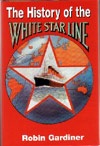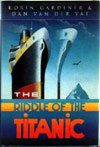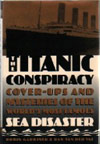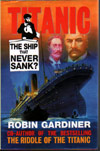|
| To Search This Site Enter Key Words Into Text Field On The Right and Hit The Search Button |
|
|
Robin Gardiner. For more information on his books, see his website TitanicConspiracy.com.
 |
Gardiner, Robin. The History of the White Star Line. 1st printing. Surrey: Ian Allan Publishing. July, 2001. hardcover. isbn: 0711028095. scarcity: fairly common.
Okay, first the good news: this book is not even remotely as bad as the editorial synopsis makes it sound. One on-line editorial states: “the reader will be able to determine that Titanic was not alone in being a victim of the company's cavalier seamanship, that many of the company's archives have mysteriously disappeared, that the company's ownership was labyrinthine (involving, as it did, the noted financier J P Morgan), and much else”.
The implication is that this book is a history of the White Star Line slanted towards conspiracies and cover-ups. Although the author introduces his story with a supposed conspiracy by Cunard to destroy all the White Star papers it could get its hands on, this angle is quickly dropped, and does not really affect the rest of the book at all.
The focus is instead on the many mishaps, major and minor, experienced by White Star ships over the years. As such it is similar to Eaton and Haas’ book Falling Star. Gardiner’s book is extensively researched, the author obviously spent a tremendous amount of time tracking down his information.
I have two problems with the result. Firstly, the author attempts to show that White Star line ships were driven recklessly by listing every conceivable accident he could uncover. This includes everything from major shipping disasters, like the loss of the Atlantic, the Republic and Titanic, to such trivial events as a ship bumping into its dock. He also lists many accidents that were completely beyond the control of the line, like ships being damaged by heavy seas and rogue waves.
More disturbing are some of the conclusions he draws from circumstantial evidence, like his inuendo that White Star wasn’t above delving into the slave trade business during rough financial times. Later in the book he has Captain Smith stating categorically that the Titanic was unsinkable: “Anyhow,” he has Smith saying, “ the Olympic is unsinkable, and Titanic will be the same when she is put in commission. Why,” he continued, “either of these vessels could be cut in halves and each half would remain afloat indefinitely. The non-sinkable vessel has been reached in these two wonderful craft”.
This is an incredible statement, but there is no documentation given for its source whatsoever.
To be fair, these radical statements are not common in the book. Another plus is that, thankfully, the author seems to have given up on his Olympic/Titanic switch theory. This concept from his first two books is almost completely ignored in this one, just a quick aside or two.
A far more serious flaw overall is that there is little to no documentation of his evidence, and there is little explanation for the incidents he relates. One example is his statement that Adriatic’s firemen mutinied when the ship was in Southampton in August of 1910. Well, why did they mutiny? We are never told.
And this is my second problem with the book. It is just a list of incidents, a very extensive list to be sure, but the explanations of these events are never fleshed out. Was White Star unique in its accident record? Hardly. If so, what were the reasons behind this? There are no answers given. The story is never put into historical perspective.
With thanks to Inger Sheil for bringing this book to my attention.
|
 |
Gardiner, Robin & Dan Van Der Vat. The Riddle of the Titanic. 1st printing. Lon: Weidenfeld & Nicolson. 1995. hardcover. isbn: 0297815288. scarcity: common.
What an unusual book this is. In the introduction, the authors propose a truly radical theory - the ship lost that fateful April night in 1912 was not the Titanic at all, but rather the Olympic. The authors believe there was a conspiracy within White Star to switch the two in the dead of night when the sister ships were in the repair yards together for a few short days in March of 1912.
The reason for this supposed switch was that the Olympic had been damaged in a collision with the warship Hawke shortly before Titanic sailed. The White Star Line supposedly wanted to sink Olympic on purpose in order to collect the insurance money. But Captain Smith messes up and wrecks the Titanic too soon and causes a real disaster instead of a faux one (he was supposed to ‘cause’ the wreck closer to New York so everyone could be rescued). The author’s introduction, which proposes this conspiracy, takes up about five pages.
Then for most of the rest of the book, some 250 pages, the authors mostly ignore the conspiracy theory, focusing instead on retelling the Titanic story including its construction, the maiden voyage, the wreck, and finally the inquiries into the disaster.
In this part of the book, the retelling of the Titanic story, the authors do a decent job. If nothing else, their views are quite different than most other authors, which makes for some interesting reading of alternate interpretations of the evidence. But the conspiracy angle is almost completely dropped, except for some ominous statements along the way that certain seemingly innocent incidents will be revealed to have a more sinister aspect further along in the book.
The promised revelation at the end of the book never materializes. By the time the reader reaches the epilogue, a mere 12 pages, the authors seem to have lost faith in their own theory. Instead of pulling all their evidence together to make the case for their conspiracy, they simply wind down with some vague comments. Their summation is very weak, and leaves more doubts about the possibility of a conspiracy than it proves.
The book does make for an interesting read, if only because the author’s approach the tale from a different perspective than most others. But there is an iceberg sized flaw in their theory that sinks it straight to the bottom. This flaw is their declaration that, except for the sliding windows on A deck, the two ships were virtually identical. That simply is not true. Titanic was very similar to, but hardly an exact copy of, Olympic. Sure, the two ships looked alike at a casual glance, but there were real structural differences that would not have stood any serious scrutiny.
For instance there is the fact that the two Millionaire’s Suites with private promenades which were on Titanic did not exist on Olympic. Even more significantly, the entire arrangement of B Deck, (the forecastle deck), was arranged completely differently on the two ships. On Olympic a first class promenade surrounded B Deck, on Titanic, cabins were built right up against the sides of the ship, so there was no promenade on this deck on Titanic.
There was no way to make the enormous number of structural changes in Olympic necessary to make her a copy of Titanic in the relatively few days the ships were in the repair yard together. And without these changes, there is no way Olympic could possibly be passed off as Titanic. The conspiracy was physically impossible.
|
 |
Gardiner, Robin & Dan Van Der Vat. The Titanic Conspiracy. 1st American printing. NY: Birch Lane. 1996. hardcover. isbn: 1559723475. scarcity: common
This is the American edition of the previous listing, Riddle of the Titanic. It was renamed for the U.S. market.
|
|
Gardiner, Robin. Titanic in Picture Postcards. Cowritten with Robert McDougall. See the complete listing, including an extensive review of the book, under McDougall.
|
|

|
Gardiner, Robin. Titanic: The Ship that Never Sank?. 1st printing. Shepperton, Surrey: Ian Allan Publishing. October, 1998. hardcover. isbn: 0711026335. scarcity: common
In this book, the author once again attempts to advance his theory, that the ship lost the night of the Titanic disaster was actually her sister ship Olympic. That the two ships were secretly switched by White Star and that Olympic was then sunk on purpose.
The reason for this supposed switch was that the Olympic had been damaged in a collision with the warship Hawke shortly before Titanic sailed. The White Star Line wanted to sink Olympic in order to collect the insurance money.
As with his first book, the author’s approach is most unusual. If the purpose of the book is to prove that a conspiracy existed, wouldn’t you expect the bulk of the book to be about that topic? Well, it is not. Rather than putting forth his evidence for a switch, Gardiner instead focuses on retelling the story of the disaster itself, but putting his own spin on the accepted version of events.
He does this by imbedding leading accusations, implying sinister motives, and asking open ended questions for which he usually supplies no answers. At the end of each chapter, there is a little box, which attempts to highlight where the accepted version of events is incorrect. The problem with this approach is that attempting to disprove accepted history is no substitute for an effort to prove new theories. It does not follow, as the author would have us think, that poking holes in what we believe to be true is the same as making a case that something entirely different happened.
As in his first book, he saves his version of the story until the very last chapter. It is a defense that takes just over five pages to tell, and is simply an itemized list of how he thinks the disaster played out. These theories contain some real whoppers, including faked passenger compartments on B deck, Titanic ramming a darkened mystery ship, collusion by Captain Lord of the Californian and other equally improbable events. There is no discussion of his claims, and few proofs offered to support them.
More disturbing is the libelous attitude Gardiner takes. There is a new, mean spirited approach towards just about everyone involved in the tragedy, which was missing from his first book. It is the kind of attack journalism that has become so popular these days, which depends on controversy and misdirection rather than reasoned logic.
It is no mistake that this book was published long after the survivors were all dead, as otherwise the author would possibly have had multiple lawsuits on his hands. Gardiner’s version of events becomes a bizarre Alice down the rabbit hole warping of history. Men like Lightoller, Lowe & Gracie who are remembered as strong men are all branded as cowards and much worse. Others like Hichens, whom history has treated less kindly, are made out to be the upstanding characters of the story.
Sometimes Gardiner bases conclusions on one particular survivor’s testimony, even though there was often multiple other survivors who gave different evidence. For example, he uses Hichen’s statement that Titanic’s rockets were red, white and blue as proof that this was so, despite the fact that no-one else aboard who spoke about the rockets stated they were any color but white. In another case, the author uses William Sloper’s testimony as the sole voice for proof that there was a darkened ship that went right by Titanic’s lifeboats. No-one else besides Sloper saw this astonishing apparition.
At other times the author’s claims are misleading, like his statement that no third class passengers were allowed to testify at the American Inquiry. Third class passengers Daniel Buckley, Berk Picard and Olaus Abelseth all gave testimony. While it is true that their testimony was not before the public inquiry panel, they all were deposed under oath by the senate committee members, and their statements properly documented by court recorders.
At times Gardiner has to reach for completely nonsensical solutions when faced with issues he cannot explain away. His answer to the argument that Titanic’s B deck had cabins built out to the sides of the hull, while Olympic had an open promenade around B deck is to state that partitions were thrown up to make it look as though passenger quarters were really there. The absurdity of this argument can be seen by the fact that Titanic’s B deck also held the two Millionaire’s suites, which were unique to that ship. The Olympic never had them. One of Titanic’s suites was used by the Cardeza’s during the maiden voyage. Did they just imagine they were living in these sumptuous quarters?
The inconsistencies go on and on, but the point has been made. This book focuses primarily on attacking the evidence instead of offering up alternate proofs. Many of the author’s criticisms are based on flimsy testimony from witnesses whose reliability is questionable. Contrary evidence, even if abundant, is ignored if it does not support the author’s agenda. These issues, taken together, damage the author’s credibility to the point that it is difficult to take his radical theories seriously.
|
|
Gardiner, Robin. White Star Line in Picture Postcards. Cowritten with Robert McDougall. See the complete listing under McDougall.
|
|
|
|
|